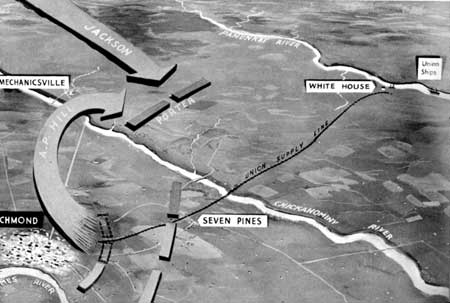|
RICHMOND National Battlefield Park |
 |
PART ONE
THE PENINSULA CAMPAIGN, SUMMER, 1862
(continued)

Lee's plan of attack.
Painting by
Sidney King.
The Seven Days Begins
McClellan's plan probably would have succeeded had Lee been willing to stand still for it. But the Confederate commander did not intend to let McClellan fight that type of warfare. As he wrote to Jackson: "Unless McClellan can be driven out of his entrenchments he will move by positions under cover of his heavy guns within shelling distance of Richmond." It was almost as if Lee had read McClellan's letter to his wife.
Lee's plan to drive McClellan away from Richmond was bold and daring, and strategically brilliant. He would bring Jackson's forces down from the valley quickly and secretly to turn McClellan's right flank at Mechanicsville. At the same time Gen. A. P. Hill's division would cross the Chickahominy at Meadow Bridge, turn east and clear the Federal forces from Mechanicsville, thereby opening the Mechanicsville Turnpike bridge for D. H. Hill and Longstreet's troops to cross. Then, in echelon, the four divisions would sweep down the north side of the Chickahominy, annihilate Porter's corps, capture the supply base at White House, then turn and destroy the rest of the Union army. With Jackson's forces and other reinforcements from farther south, Lee would have about 90,000 men, the largest army he would ever command in the field.
To protect Richmond, he planned to leave about one-third of his army, under Generals John B. Magruder and Benjamin Huger, in the entrenchments around the city to hold back the main part of McClellan's force, about 70,000 men, from marching into the Confederate Capital. If this force started to withdraw, then Magruder and Huger would attack.
Lee apparently believed that McClellan would try to retreat to his base at White House, or failing that, would retire back down the peninsula. He assured Jefferson Davis that "any advance of the enemy toward Richmond will be prevented by vigorously following his rear and crippling and arresting his progress." The strategy was just about perfect, but, unfortunately for Lee, the tactics were not.
On the morning of June 25 the Seven Days began with the advance of Hooker's division along the Williamsburg road at Oak Grove, preparatory to a general advance McClellan planned for the next day. But Hooker ran into strong opposition from Huger's troops, and when McClellan received intelligence of Jackson's approach, Hooker was ordered back. McClellan wired Washington: "I incline to think that Jackson will attack my right and rear." He had delayed too long—the next day Lee wrested the initiative from him.

|

|
|
Last Modified: Mon, Mar 4 2002 10:00:00 pm PDT |


